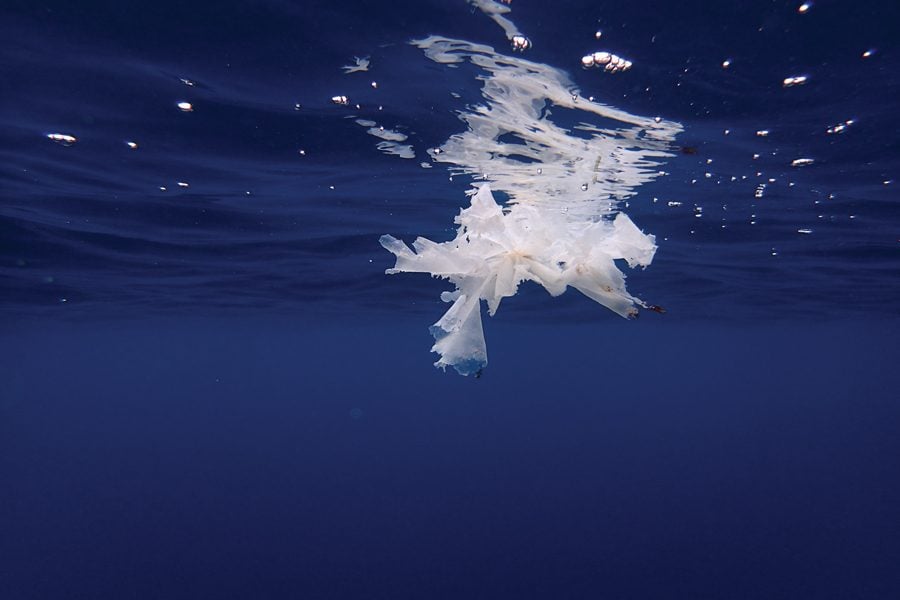Abroad Brush Strokes: Plastic jellyfish and giant mantas in Bali
Alex Schwartz / The Daily Northwestern
A plastic bag floats below the surface at Manta Point, off the coast of Bali. Plastics large and small are beginning to clog Indonesia’s crucial current passages, spelling trouble for marine life.
October 4, 2018
In this series, a writer recounts his experiences studying environments and natural resources in Indonesia.
When I jump into the water at Manta Point, the first thing I see is a plastic bag.
I almost mistake it for a jellyfish as it floats just below the surface: ripped, gnarled and ghostly white against a backdrop of deep blue. I begin to imagine it as a new species, albeit lifeless, invading the complex underwater web of life. Who will it choke? Who will it smother?
I’m off the southwestern coast of Nusa Penida, a small island in Bali’s rainshadow. Working partially on behalf of the Marine Megafauna Foundation — an international charitable organization dedicated to the research and conservation of extra-large sea creatures — our curious mix of first-time snorkelers and experienced SCUBA divers has one mission: to find and identify manta rays.
The Nusa Islands, as they’re sometimes referred to, sit smack in the middle of an incredibly biodiverse stretch of sea. Indonesia’s over 17,000 islands lie at a vast marine crossroads, serving as a buffer between the Indian and Pacific Oceans. Currents from the northeast, containing huge amounts of nutrients, plankton and larvae from throughout the Pacific, spill through a few gaps between the islands as they travel southwest toward the Indian Ocean. The deep, narrow expanse of water I’m floating in is one of these passageways. The scattered islands and gaps between them, combined with the constant stream of life-giving material from both the Pacific and Indian oceans, give Indonesian reefs the highest diversity of coral reef fish species on the planet. In fact, much of Indonesia comprises the Coral Triangle, an area that contains around 76 percent of the world’s coral species.
This is the perfect underwater cocktail that plankton feeders — like manta rays — can’t get enough of. Now, trash discarded into oceans around the world is being added to the mix.
My mind returns to a video I saw on Facebook a couple weeks ago, in which a SCUBA diver made his way through a sea filled with trash. Coincidentally, that spot was Manta Point, where I saw that jarring plastic cnidarian. In recent years, the island has experienced occasional blooms of plastic along its coast. These occurrences depend on weather and currents, but they’ll only get worse as waste continues to pollute our oceans.
Luckily, the plastic bag — along with a few other small pieces of trash we later pick up in the vicinity — is about as much trash as we encounter, and we still have the visibility we need to see manta rays. I power through despite my constantly-fogging mask, trying to make out the underwater vista before me. It’s deep, dark and pretty chilly for being just eight degrees south of the equator (that’s the fault of those cold upwellings from the Indian Ocean). As we swim closer to shore, I begin to make out a rocky drop-off: a manta cleaning station. The rays will glide up here for a bit of a spa break during their lengthy oceanic journeys. A host of small, eager fish are ready to receive them, eating their parasites and cleaning their wounds before they’re ready to swim back out to sea.
Soon enough, the seasickness-ridden trip to Manta Point pays off. I hear a muffled shriek from within our snorkel formation and pan my head downward. A grey diamond the size of a Mini Cooper floats below us, headed toward the cleaning station. Its wings undulate hypnotically as it curls up its head fins. I stare at it incredulously — I feel like I’ve been shrunk down. I’d heard about how these mantas can grow up to five meters wide, but it’s impossible to fully capture their majesty in words or even pictures.
By the time I get out of the water, my teeth chattering and my adrenaline pumping, I’ve seen about five — If I hadn’t been biting my snorkel, my jaw would have dropped.
I’m thankful to have avoided encountering a trashy tide like the one in that haunting viral video, but the problem reaches beyond that. Even when the water is clear, microplastics may be poisoning mantas and other marine organisms around the world. They’re carried along currents and end up on coastal reefs just like larvae and plankton. Indonesia has a littering problem that should be addressed, but what many people fail to realize is that much of the trash here comes from throughout the Pacific, brought by the very life-giving currents that make this area so biodiverse.
In other words, the now faded plastic bag I encountered thousands of miles away from American shores could have very well once sported an In-N-Out Burger logo. Perhaps it was left on a beach in Los Angeles or San Diego, washed out to sea by the tide and carried all the way to the other side of the world. A lifeless jellyfish among the mantas — and all the more deadly.
Alex Schwartz is a Medill junior. He can be contacted at [email protected]. If you would like to respond publicly to this op-ed, send a Letter to the Editor to [email protected]. The views expressed in this piece do not necessarily reflect the views of all staff members of The Daily Northwestern.


